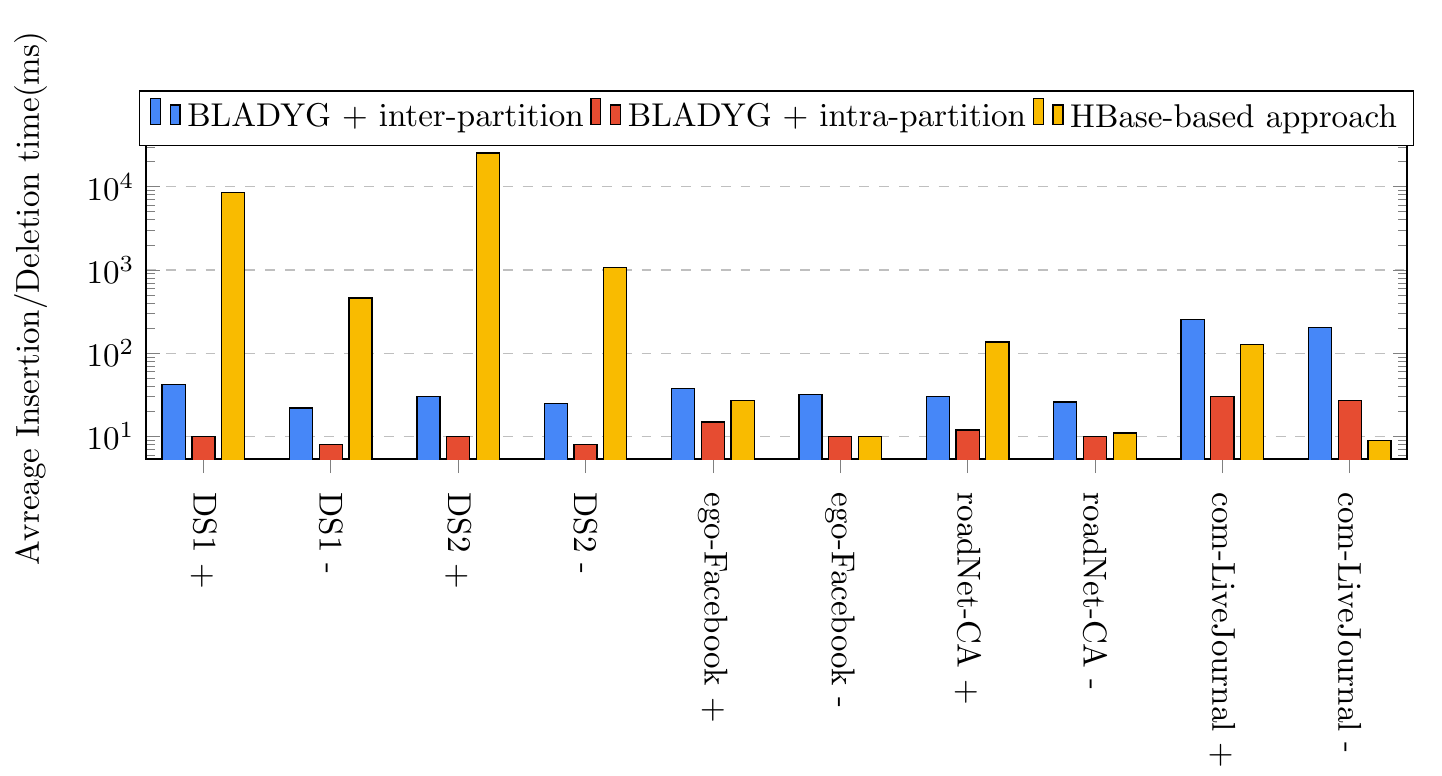-
-
Recently, distributed processing of large dynamic graphs has become very popular, especially in certain domains such as social network analysis, Web graph analysis and spatial network analysis. In this context, many distributed/parallel graph processing systems have been proposed, such as Pregel, GraphLab, and Trinity. These systems can be divided into two categories: (1) vertex-centric and (2) block-centric approaches. In vertex-centric approaches, each vertex corresponds to a process, and message are exchanged among vertices. In block-centric approaches, the unit of computation is a block, a connected subgraph of the graph, and message exchanges occur among blocks. In this work, we are considering the issues of scale and dynamism in the case of block-centric approaches. We present BLADYG, a block-centric framework that addresses the issue of dynamism in large-scale graphs. BLADYG is implemented on top of AKKA framework.

BLADYG System overview
We have applied BLADYG framework to the problem of distributed k-core decomposition in large dynamic graphs. We have performed a set of experiments to evaluate the effectiveness and efficiency of BLADYG framework on a number of different real and synthetic datasets.
- Experimental environment
We have implemented BLADYG on top of the akka framework, a toolkit and runtime for building highly concurrent, distributed, resilient message-driven applications. In order to evaluate the performance of our approach, we used 9 m3.medium instances on Amazon EC2. Each m3.medium instance contained 1 virtual 64-bit CPU, 3.75 GB of main memory a 4 GB of local instance storage.
We compared our BLADYG solution for k-core decomposition with a HBase-based solution proposed by Aksu et al. [1]. The HBase-based solution was tested using 9 m3.medium instances on Amazon EC2: 1 acting as hmaster, namenode and zookeeper node, 8 as datanode and hregion.- Datasets
In order to evaluate and test the effectiveness of BLADYG, we performed an extensive set of experiments on a number of different real and synthetic datasets.
Datasets Dataset Type Number of nodes (N) Number of edges (M) Diameter Average clustering coefficient Max(k) DS1 Synthetic 10,000 70,622 4 0.3977 33 DS2 Synthetic 20,000 144,741 4 0.3935 38 DS3 Synthetic 50,000 365,883 4 0.3929 42 DS4 Synthetic 100,000 734,416 4 0.3908 46 ego-Facebook Real 4,039 88,234 8 0.6055 115 email-Enron Real 36,692 183,831 11 0.4970 43 roadNet-TX Real 1,379,917 1,921,660 1,054 0.0470 3 roadNet-CA Real 1,965,206 2,766,607 849 0.0464 3 com-LiveJournal Real 3,997,962 34,681,189 17 0.2843 296 soc-LiveJournal1 Real 4,847,571 68,993,773 16 0.2742 318 Real datasets are provided by Stanford University (SNAP).
Synthetic datasets were created using the graph data generator proposed by [2] [3].- Scalability
- We mention that the presented runtime values of the HBase-based approach correspond to the maintenance time of only one fixed k value core (k = max(k) in our experimental study). This means that, for each dataset, the maintenance process of the HBase-based approach needs to be repeated max(k) times in order to achieve the same results as our approach.
-
BLADYG source code is downloadable here.
Our Java implementation of the HBase-based [1] approach is available here. - S. Aridhi, A. Montresor, Y. Velegrakis. BLADYG: A Graph Processing Framework for Large Dynamic Graphs. Big Data Research (BDR), Elsevier, 9(C), pp. 9-17, 2017.
- S. Aridhi, M. Brugnara,A. Montresor, Y. Velegrakis. Distributed k-core Decomposition and Maintenance in Large Dynamic Graphs. In Proceedings of the 10th ACM International Conference on Distributed and Event-Based Systems (DEBS'16), pp. 161-168, Irvine, 2016.
- C. Sakouhi, S. Aridhi, A. Guerrieri, S. Sassi and A. Montresor. DynamicDFEP: A distributed edge partitioning approach for large dynamic graphs. In Proceedings of the 20th International Database Engineering & Applications Symposium (IDEAS'16), pp. 61-168, Montreal, Canada, 2016.
-
Aridhi S., Montresor A., Velegrakis Y. BLADYG: A novel block-centric framework for the analysis of large dynamic graphs. In Proceedings of the ACM Workshop on High Performance Graph Processing (HPGP'16) @ HPDC'16, pp. 39-42, Kyoto, Japan, 2016.
-
[1] Aksu H., Canim M., Yuan-Chi Chang, Korpeoglu I., Ulusoy O. Distributed k-Core View Materialization and Maintenance for Large Dynamic Graphs. IEEE Transactions on Knowledge and Data Engineering, vol.26, no.10, pp.2439-2452, Oct. 2014
[2] Alessandra Sala, Lili Cao, Christo Wilson, Robert Zablit, Haitao Zheng, and Ben Y. Zhao. Measurement-calibrated Graph Models for Social Network Experiments. Proceedings of The 19th World Wide Web Conference (WWW 2010). ACM, New York, NY, USA, 861-870.
[3] Alessandra Sala, Xiaohan Zhao, Christo Wilson, Haitao Zheng, and Ben Y. Zhao. Sharing Graphs using Differentially Private Graph Models. Proceedings of The 11th ACM SIGCOMM Internet Measurement Conference (IMC 2011). ACM, New York, NY, USA, 81-98.
-
